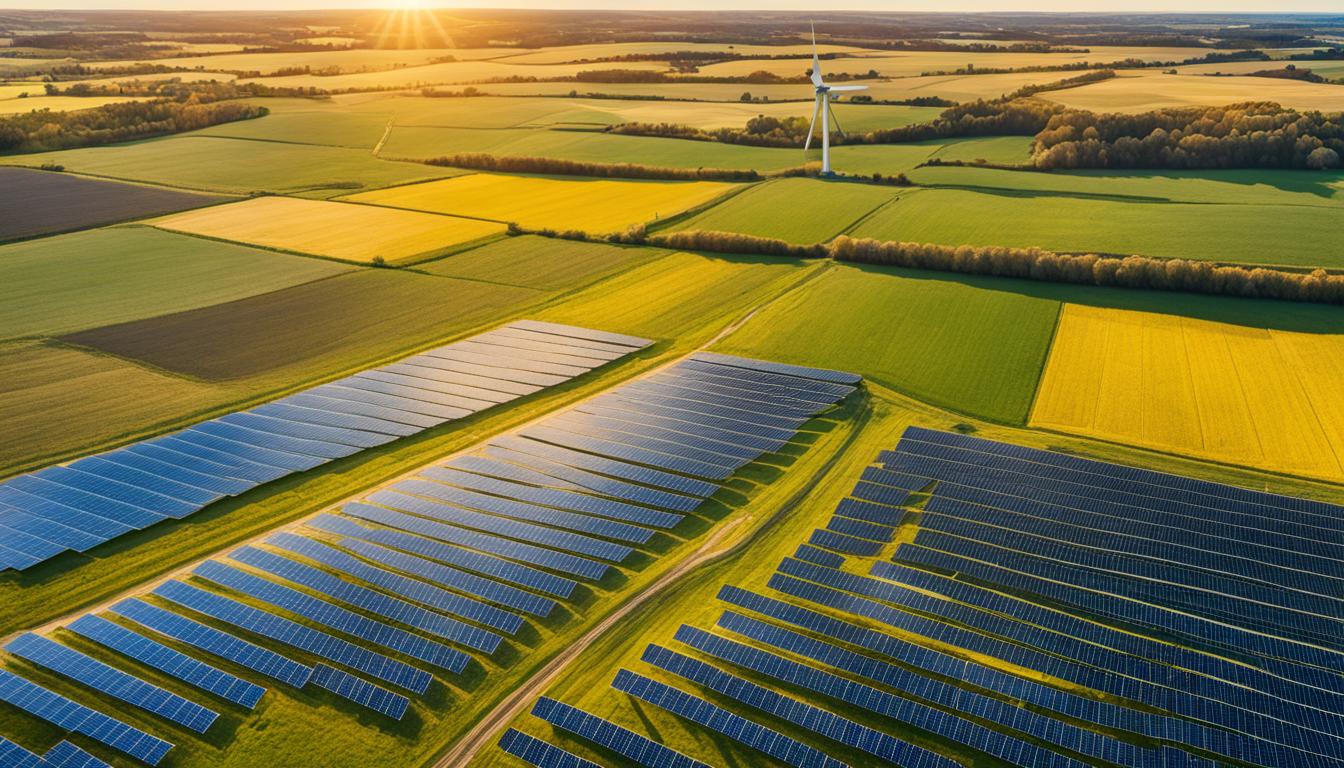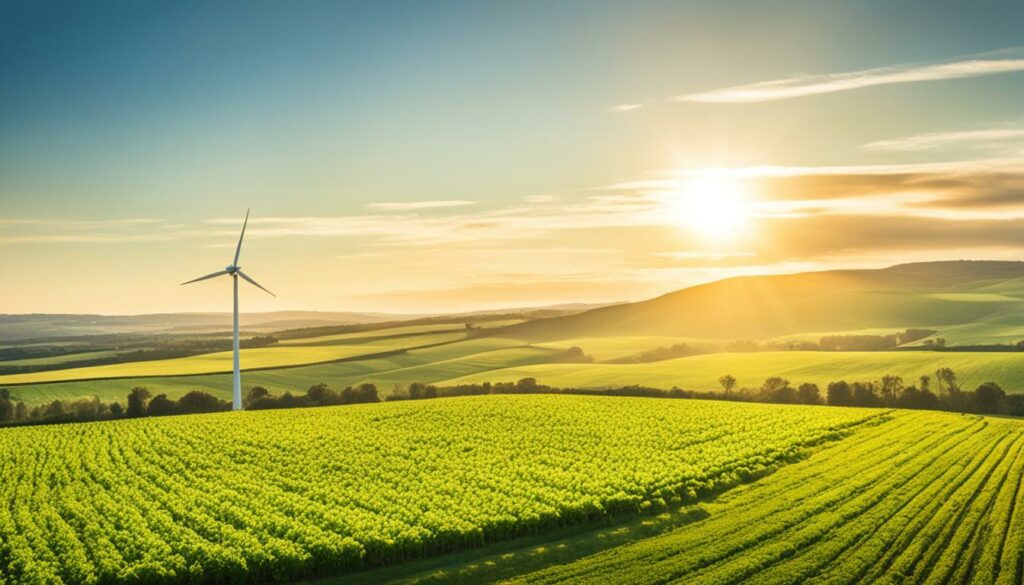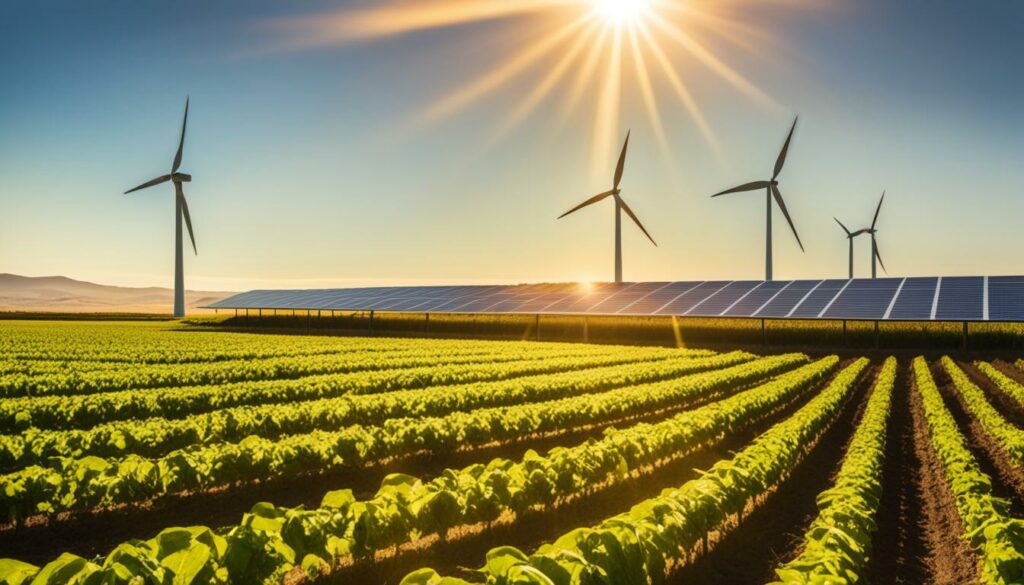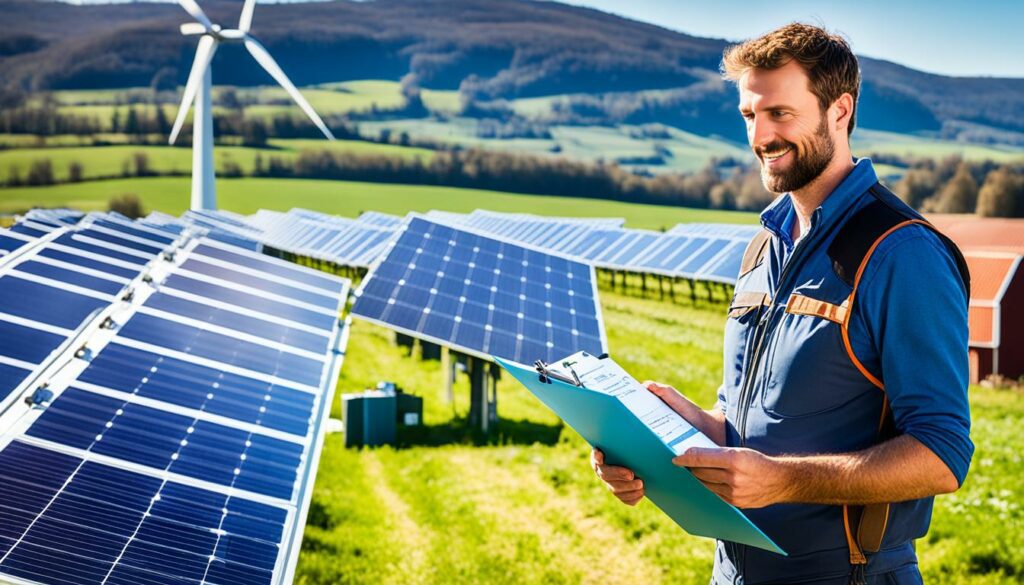Menu

Have you heard that extreme weather in the last fifty years cost over $4.3 trillion and led to more than two million deaths? This comes from the World Meteorological Organization (WMO). These numbers emphasise the urgent need for a shift to renewable energy. In the United States, as of November 8, 2023, there have been 25 disasters this year, each causing over $1 billion in losses. Such events highlight the move towards renewable energy, especially in farming, to cut down on greenhouse gases and fight climate change.
There’s a push for farmers to adopt renewable energy when they farm. This not only helps the planet but also saves them money in the long run. It helps them cope better with bad weather too.
Renewable energy mandates push the move to cleaner energy from fossil fuels. They require a set percentage of energy use to come from green sources. This aims to boost the use of renewable tech and cut down on greenhouse gases.
Renewable energy mandates mean a certain part of a place’s energy must be from green sources. They set goals that encourage putting money into green tech. This helps make green energy from the sun, wind, and water more affordable.
Looking at the numbers, wind power has grown a lot, from 23,900 megawatts in 2001 to over 539,000 megawatts in 2017. This was more than a 22 times increase. Also, between 2007 and 2017, solar panel energy jumped by 4,300 percent. These facts show big changes thanks to green energy laws.
The push for green energy laws comes from many reasons. People want to live in a way that helps the planet. New tech, like efficient home systems and electric cars, make switching to green power easier.
Also, world promises like the Paris Agreement push countries to make less pollution. In the U.S., 29 states say energy must come partly from green sources. And 30 states plus others aim for completely green energy. These laws are making a big difference.
Farms benefit a lot from switching to green energy. New tech means better efficiency and lower costs. It helps farms follow the need for more sustainable ways.
To sum up, changing to green energy is crucial for the planet and our wallets. It shows how important these laws are for our future energy use.
Switching agriculture to renewable energy matters a lot. It helps our planet and our pockets. The food industry creates almost one-third of the world’s greenhouse gases. Changing to renewable energy is a big step to slow down climate change.

Clean energy in farming can cut a lot of greenhouse gas emissions. Global farm business makes up 30% of all emissions. Most of the energy it uses comes from fossil fuels. By using renewable energy, we can reduce these harmful emissions. This is vital if we want to keep global warming under a dangerous limit when food demand goes up by 2050.
Moving to clean energy doesn’t just help the environment. It also has good economic points. It shields farmers from the ever-changing prices of fossil fuels. Plus, they can make money selling extra power. Right now, most new solar projects are happening on farms. This shows a strong link between farming and renewable energy.
Solar energy can make more money for farmers than wind. This can be a good way for them to earn extra cash. By preparing for climate change now, farmers are also protecting their businesses and incomes for the future.
It’s vital to check how much energy farms use. This helps them manage energy better and follow eco-friendly farming rules. By looking at how they use energy, farmers can see what’s not working well. Then, they can fix these issues to save money and be greener.
Energy audits show how energy is used on a farm. They look closely at energy use and find where it’s being wasted. These checks help farms use green energy bonuses wisely. They give clear advice on adding renewable tech the right way.
After doing an energy audit, farms can find what’s not efficient. Maybe they have old devices, not enough insulation, or use energy poorly. Improving these can save a lot of energy. It also helps farms qualify for green energy bonuses and meet eco-farming standards.
For example, California wants new homes to have solar panels and saves energy through net metering. Places like Arizona and Arkansas make it easier to tax farms that help the environment. Doing these energy checks and fixing problems can make farms better at following green energy rules. This makes farming more sustainable and smart economically.
Renewable energy tech in farming boosts sustainability and efficiency. It allows farmers to use less fossil fuel. This helps make agriculture more eco-friendly.

Solar power is becoming more common in farming. Technologies like solar panels and agrivoltaics are used. These let farmers catch solar energy without losing space for plants. Agrivoltaics combines solar panels with growing crops, making better use of land.
Wind turbines help farms in windy places make electricity. This green approach cuts down on harmful emissions. It also shows a farm is trying to be more eco-friendly. So, it’s a good choice over using oil and gas.
Biogas makes energy from farm waste. It turns old plants and manure into a gas that can be used for power. This way, farms help the planet by cutting waste and reducing their need for other energy.
For wet farm areas, hydropower is a smart choice. This tech uses the power of moving water to create electric power. It’s a clean and reliable way to meet a farm’s energy needs. Plus, it’s good for the environment.
These techs show how agriculture can go green. Using solar, wind, and other renewable energy sources, farms can reduce their impact on the planet. They also become more able to face economic challenges. It’s all part of fighting climate change.
Understanding and meeting sustainable agriculture rules is key today. Farmers who follow these rules often see more money and become less dependent on others for energy. This is because many places give perks to those who stick to the rules.
Take California, for example. It has lots of laws that help both farmers and homeowners switch to cleaner energy. All new homes in the state must have solar panels. Homeowners even get paid for extra power they share with the grid. Plus, there are more options like buying electricity from sources that use renewables.
Many other states are also big on the advantages of green energy in farming. Alaska wants half of its power to come from green sources by 2025. This makes buying renewables an enticing choice for farmers. Arkansas and Arizona have ways to show that using land well and making money can go together with green farming.
Putting cash into renewable energy is a smart move for farmers now. The market is worth a lot, and it’s growing fast. Places that support green energy with money help lower the cost for farmers. Right now, 30 states, D.C., and two territories have rules that push for more green or clean energy.
By sticking to the green rules and using renewable energy, farmers can save money in the long run and stand up better to climate change. This not only helps the earth but also makes the farming world stronger and more lasting.
| State | Renewable Energy Goals and Programs |
|---|---|
| Alaska | 50% electricity generation from renewable sources by 2025 |
| California | 60% retail electricity sales from renewable sources by 2030; mandatory solar photovoltaic systems for new homes; Green Tariff Shared Renewables Program; net energy metering |
| Arkansas | Valuation of agricultural land based on productivity and conservation easements |
| Arizona | Agricultural land valuation based on income approach |
Today, farmers can turn challenges into opportunities by embracing renewable energy. To do so, they should know about the financial rewards available to them.

The USDA plans to invest more than $24 billion by 2031 in helping farmers go green. This money is earmarked for grants and subsidies to ease the costs of switching to sustainable energy. It means farmers of all kinds can join this movement, whether their farms are small or large.
Tax incentives from the government are key to making renewable energy projects affordable. Essential among them are the Renewable Electricity Production Tax Credit (PTC), the Investment Tax Credit (ITC), and MACRS. These incentives help farmers reduce their tax bills while growing their investment in eco-friendly energy sources.
Beyond government support, private investments from companies and individuals can also boost green farming. These investors provide not just money but also valuable knowledge. In exchange, they get a part of the benefits that come from being more environmentally friendly over the long term. This approach speeds up the use of renewable energy and innovation in farming.
At the moment, much of the agricultural sector still heavily relies on fossil fuels. But with only 13% of farmers embracing on-farm green energy and a small increase expected in the next two years, there’s a big chance for growth. Financial incentives and investments not only help farm finances but also the planet.
Bringing renewable energy into farm life needs lots of thought. You’ve got to learn about farming and green energy. Looking at successful farms that are going green can show us how to do this right.
Knowlton farm, for instance, upped their solar power game in 2015 and 2017. They added 6.2 MW by placing solar panels on 19 acres. This change is saving the local folks roughly $10 million on power bills. They also use some of the land for farming strawberries and more, while animals can graze too.
In Maine, a blueberry farm uses ten acres for a 4.2 MW solar project. These examples show how farms can make power and still farm.
Here are tips for successful green energy farming:
These steps help farms switch to greener energy smoothly. It keeps the farm in line with laws and brings all the good things green energy offers in the long run.
Switching to renewable energy in farming faces many hurdles. This includes technical and economic challenges. To move to sustainable energy, the agriculture sector needs strategic solutions and investments.
Transitioning to renewable energy faces key technical hurdles. These include storing energy and maintaining a reliable grid. Current battery tech is expensive for long storage and might stay that way for a decade.
Paying for high transmission costs and the effort it takes to build multi-state lines also makes things tough. Many farms can’t swap diesel for electric machines, especially for long hours. This makes electrification hard during planting and harvesting.
Innovation and investment are key to tackling these technical barriers. John Deere, for example, works on charging systems and better batteries for farm use. Some solutions include electric meters that talk to energy suppliers to help manage power use.

The financial issues in moving to renewable energy are also big. Solar and wind power need massive investments, but these aren’t happening at the required levels. This slows down the switch to sustainable energy.
To help farmers afford the move to renewables, various strategies are available. Government investments in new energy technology can help share knowledge. Financial benefits like subsidies and tax breaks make renewable energy options more affordable. Even companies like New York State Electric and Gas give farm-specific help to save energy.
It’s important to combine tech progress, investments, and better knowledge sharing to solve the technical barriers and deal with the economic issues. This approach is essential for a green and efficient future in farming.
Rural cooperatives have always been essential in farming areas. They help farmers move towards renewable energy. By coming together to invest, these groups help start up energy projects. This way, everyone gains more from moving to sustainable ways.
When a whole community supports green farming, change happens smoothly. This mix of group help and cooperation makes farms more resilient. Now, let’s look at how this can work for anyone wanting to join in.
Working together is key in rural energy projects. Here are the top benefits:
Many groups and resources are out there to help rural energy projects. These include:
| Resource | Support Offered |
|---|---|
| USDA Cooperative Services | They give tech help, funding tips, and advice for starting and keeping cooperatives. |
| Interagency Working Group on Cooperative Development | Federal groups and cooperatives work together for better development. |
| State and Local Cooperative Associations | They offer local help, tips, and workshops. |
To wrap up, the help of the community in green farming is huge. Supporting these cooperative efforts pushes forward with green energy. It means all farmers can enjoy the good points of these changes.
Renewable energy in farming is good for the environment and boosts farm work a lot. Using renewable energy changes many farming areas for the better. It shows how renewable energy can completely transform farming.
Renewable energy helps farm outputs, especially in crops and soil health. Agrivoltaics uses land for both solar power and farming. This mix boosts soil moisture, vital for crop growth. Solar panels can improve soil health by providing shade. This cuts down water loss from evaporation, improving crop growth.

Long-term success in farming means embracing renewable energy. Moving from traditional to solar and wind energy helps the soil stay healthy. It also makes farms sustainable for the long haul. Renewable energy like solar panels and wind turbines fights pollution. It reduces harmful emissions, meeting energy needs while protecting the planet for our children.
The U.S. Renewable Fuel Standard (RFS) makes using renewable energy even more urgent. In the U.S., 30 million acres are used to grow corn for making ethanol. Yet, ethanol is mainly for energy, not food. Solar power, on the other hand, if used instead, could meet the U.S.’s whole electricity need using less land.
| Energy Source | Land Usage (acres) | Yield (MWh/year) | Potential Impact |
|---|---|---|---|
| Solar Panels | 10 million | 394-447 | Higher efficiency and sustainable soil management |
| Corn for Ethanol | 30 million | N/A | Insufficient for long-term sustainability |
Overall, renewable energy makes a huge difference in farming. It leads the way to better soil and bigger crops. Looking ahead, adopting renewable tech will only make farming more sustainable and effective.
The future of renewable energy in agriculture will change farm life a lot. Heading towards a greener future includes new tech and ways to farm sustainably. Understanding these trends and tech is vital.
New technologies lead this change. For example, solar energy is a great hope for the future. Solar panels offer much more energy production than crops like corn for ethanol. This shift boosts energy efficiency and cuts back on fossil fuel use, which causes a lot of the world’s greenhouse gases.
Next, we have advancements in storing energy. Companies like John Deere are now focusing on making better batteries. These batteries will help store the energy from solar and wind power, ensuring farms have electricity when they need it.
Farmers are moving towards more renewable energy use. In places like New York, the goal is 70% renewable energy by 2030. Specific laws and frameworks guide the agriculture sector in reaching these targets. Support, like what NYSEG offers, helps farms improve energy use and meet these goals.
The global agriculture business is also changing fast. Green practices are now both a must and an opportunity. For example, farmers can earn a steady income from solar leases for their land. This helps amid rising costs and energy prices.
Africa is highlighting its potential in sustainable agriculture. It faces challenges but has lots of unused land. The right tech and investments can make a big difference in Africa’s farming future.
Renewable energy is key in feeding the world sustainably by 2050. Governments, farmers, and companies are joining forces to make agriculture cleaner and more efficient. This will lead to a better future for farming worldwide.
Starting with renewable energy on your farm can be great for the planet and your pocket. This guide will help farmers move to greener ways smoothly.

Getting the right resources can simplify the process. Here’s a list of key contacts and resources for US farmers:
| Resource | Agency/Organisation |
|---|---|
| Energy Audits | US Department of Agriculture (USDA) |
| Solar Energy Guidance | Solar Energy Industries Association (SEIA) |
| Wind Energy Support | American Wind Energy Association (AWEA) |
| Biogas Information | Biogas Association |
| Hydropower Advice | National Hydropower Association (NHA) |
| Subsidies and Grants | Database of State Incentives for Renewables & Efficiency (DSIRE) |
Working with the right people and groups is crucial. They can offer a lot of help and make the shift to renewable energy smoother for farmers.
Farmers are realising the need to make more money while being sustainable. This approach helps the environment and opens doors for new businesses.
To increase profits and help the planet, farms can start using less energy. They can do this by using solar and wind power. These steps cut down the need for fossil fuels, which are used too much in food production.
Using renewable energy can also save farms money and shield them from high fuel prices. Nearly a third of the world’s harmful emissions come from producing food. So, using less energy benefits everyone.
Investing in efficient equipment and checking energy use regularly can save a lot of money. It makes farms run better and cheaper in the long run.
Farming sustainably can also boost profits by appealing to more customers. People are ready to pay more for products that help the environment. This change in buying habits lets farmers stand out in the market.
Eco-labels and certifications show a farm is serious about being green. This attracts shoppers who care about the planet. By going green, farms can reach a wider market that wants to support eco-friendly brands. Not only does this improve sales, but it also makes the farm more respected in the industry.
Here’s a brief comparison of traditional vs. renewable energy farming practices and their potential benefits:
| Aspect | Traditional Energy Farming | Renewable Energy Farming |
|---|---|---|
| Energy Source | Fossil Fuels | Solar, Wind, Bioenergy |
| GHG Emissions | High | Low |
| Energy Costs | Variable, Increasing | Stable, Decreasing Over Time |
| Market Opportunities | Limited | Expanding, Premium Pricing |
Finding a balance between making profits and looking after the planet can benefit farmers a lot. Doing this can help fight climate change and keep agriculture going strong for the future.
The move to renewable energy is key for making farming more sustainable and strong. Farmers using renewable energy can cut carbon pollution and make more money. With the cost of crops going up because of biofuels, it’s clear that using different energy sources is vital. For example, the ethanol demand caused a 30% jump in corn prices.
This shows why it’s crucial to look at the big picture of renewable energy. The food crisis in 2007/2008 made 75 million more people face starvation. It was partly because of biofuel policies in the U.S., EU, and Brazil. The crisis showed the need for balanced, smart farming rules. Using renewable energy on farms can help stop such big problems, making food more stable and fair for everyone.
Farmers choosing renewable energy do more than follow rules. They help make farming last longer, fight climate change, and give energy fairly. This change can let farms lead in taking care of our planet. It also opens doors to new ways for farming to grow. By choosing renewable energy, the agriculture sector stays strong and does good for the world.
Renewable energy mandates are policies. They need a set amount of energy to be from renewable sources. These rules help move away from polluting fuels. This shift cuts down on the greenhouse gases we release into the air.
People want to live in a more sustainable world. New technology has made clean energy more practical. It also helps the economy and meets global agreements to lower pollution levels.
Switching to renewable energy in farming lowers emissions. It helps fight climate change and protects the land. It means a cleaner world and better farming for the future.
Using renewable energy shields against high fuel prices. It cuts the cost of energy and can even make money by selling extra energy. Plus, farmers might get bonuses for going green.
Energy audits show where farms are wasting energy. They spot places to save and improve. This helps farmers choose the best green energy options and follow environment-friendly rules.
Farms can use solar panels, windmills, and systems that turn waste into energy. There are also water power solutions. These help farms meet their clean energy goals.
Governments give money, tax breaks, and help pay for some costs. These offers make starting renewable energy projects more doable for farmers.
To do it right, plan well, get expert advice, and check it fits with what the farm already does. Also, learn from others who have succeeded in using green energy effectively.
Farmers could find it hard to store energy and trust the power supplies. The cost and how markets change are also big worries. Solving these problems takes teamwork and good plans.
Groups in the countryside can join forces to buy better technology and share the cost. This makes the switch to green energy easier and more affordable for farmers.
Using sun for energy can make the soil better for crops. Farming becomes more sustainable and can grow more food. Less reliance on fossil fuels is good for the long run too.
The future is bright with new solar technology and better ways to store energy. These updates will make green energy in farming more practical and bigger than ever before.
Start with finding out where the farm uses energy. Then make a plan, install new systems, and keep everything working well. Use help from experts and government programs throughout the process.
Saving energy and choosing green options can lower costs and bring in more money. Selling eco-friendly products can also attract customers who want to support the environment. This way, farms can be both profitable and good for the planet.